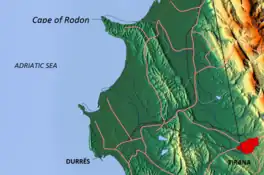Cape of Rodon
The Cape of Rodon or Cape of Skanderbeg (Albanian: Kepi i Rodonit or Kepi i Skenderbeut) is a rocky cape on the Adriatic Sea north of Durrës, Albania.[3] On the Cape is the Rodoni Castle, built by Skanderbeg in 1463.[4] and a Saint Anthony Church. Further south in the bay between the cape and Rrushkull Reserve there exist several beach resorts like Fshati Turistik Lura while Lalzit Bay Resort is under construction.
| Cape of Rodon | |
|---|---|
 Map of the Cape of Rodon | |
 Cape of Rodon | |
| Location | Southern Europe |
| Coordinates | 41°35′9″N 19°26′59″E |
| Ocean/sea sources | Adriatic Sea, Mediterranean Sea |
| Basin countries | Albania |
| Settlements | Durrës |
| Location | Cape of Rodon, Albania |
|---|---|
| Coordinates | 41°35′03″N 19°26′59″E |
| Tower | |
| Constructed | 1884 (first) |
| Foundation | concrete base |
| Construction | metal lamp post |
| Height | 3 m (9.8 ft) |
| Shape | cylindrical lamp post[1] |
| Markings | grey metal post with light atop[2] |
| Power source | solar power |
| Light | |
| First lit | 2007 (current) |
| Focal height | 40 m (130 ft) |
| Range | 8 nmi (15 km; 9.2 mi) |
| Characteristic | Fl(2) W 10s |
Name
The name Redon appears in ancient inscriptions found in Santa Maria di Leuca (present-day Lecce), and on coins minted by the Illyrian city of Lissos, suggesting that he was worshipped as the guardian deity of the city,[5] and probably as a sea god.[6] The fact that Redon was always depicted on coins wearing a petasos demonstrates a connection with travelling and sailing, which led historians to the conclusion that Redon was the deity protector of travellers and sailors.[7] Indeed, the inscriptions of Santa Maria di Leuca were carved by the crews of two Roman merchant ships manned by Illyrians.[8] Inscriptions mentioning Redon were also found on coins from the Illyrian cities of Daorson and Scodra, and even in archaeological findings from Dyrrhachium after the establishment of a Roman colony there.[7] His name keeps on being used in the Albanian Kepi i Rodonit, which could be analysed as an Illyrian sanctuary dedicated to the god of the sailors in the past.[9]
See also
Sources
Citations
- List of Lights, Pub. 113: The West Coasts of Europe and Africa, the Mediterranean Sea, Black Sea and Azovskoye More (Sea of Azov) (PDF). List of Lights. United States National Geospatial-Intelligence Agency. 2015.
- Rowlett, Russ. "Lighthouses of Albania". The Lighthouse Directory. University of North Carolina at Chapel Hill. Retrieved 6 April 2017.
- Geonames. "GeoNames Fulltextsearch : kepi i rodonit". Retrieved 7 November 2010.
- Tauleda. "Kalaja e Skenderbeut, Kepi i Rodonit". Archived from the original on 14 March 2012. Retrieved 7 November 2010.
- Dyczek et al. 2014, pp. 82–83.
- Ceka 2013, p. 348.
- Ceka 2013, pp. 230, 348.
- Ceka 2013, pp. 230, 348; Dyczek et al. 2014, pp. 82–83
- Ceka 2013, p. 230.
Bibliography
- Ceka, Neritan (2013). The Illyrians to the Albanians. Tirana: Migjeni. ISBN 9789928407467.
- Dyczek, Piotr; Kolendo, Jerzy; Łajtar, Adam; Plóciennik, Tomasz; Rzepkowski, Krzysztof (2014). "Une inscription métrique de Lambaesis (CIL, VIII, 2581 ; F. Buecheler, Carmina Latina epigraphica, 1527) et la statue du dieu illyrien Médaure". Antiquités africaines (in French). 50 (1): 73–84. doi:10.3406/antaf.2014.1560.